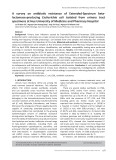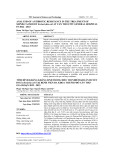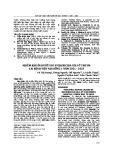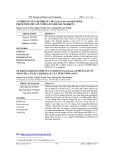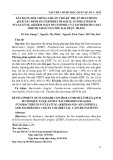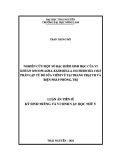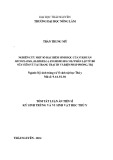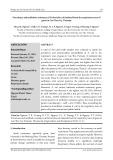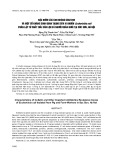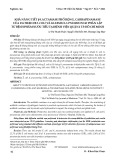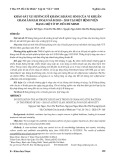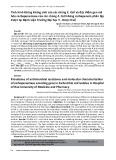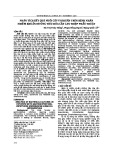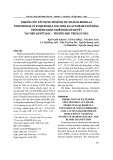MINISTRY OF EDUCATION AND TRAINING MINISTRY OF DEFENSE
108 INSTITUTE OF CLINICAL MEDICAL AND PHARMACEUTICAL SCIENCES
TRINH VAN SON
INVESTIGATION OF BETA-LACTAM RESISTANCE
AND GENES ENCODING BETA-LACTAMASE OF
ESCHERICHIA COLI AND KLEBSIELLA PNEUMONIAE
CAUSING BLOODSTREAM INFECTIONS
Specialty: Infectious and Tropical Diseases
Educational code: 62720153
SUMMARY OF MEDICAL PhD THESIS
Hanoi - 2021
THE RESEARCH WAS DONE AT:
108 INSTITUTE OF CLINICAL MEDICAL AND PHARMACEUTICAL SCIENCES
Supervisors:
1. A/Prof. Le Huu Song, MD, PhD
2. Dr. Nguyên Đang Manh, MD, PhD
Reviewer 1: ……. Reviewer 2: ……. Reviewer 3: …….
The Institutional thesis defense meeting will take place at 108 Institute of Clinical Medical and Pharmaceutical Sciences At …… h …. month day, year
The thesis was stored at:
1. National library of Vietnam 2. The Library of 108 Institute of Clinical Medical and
Pharmaceutical Sciences
1
INTRODUCTION
Significance of the research
Bloodstream infection (BSI) is a potentially life-threatening
condition and has become a major challenge for healthcare system
worldwide, that have affected the million people with increasing
morbidity and mortality, especially BSI caused by multidrug resistant
bacteria. The reports demonstrate the percentage of bacteria producing
extended spectrum beta-lactamase (ESBL) are increasing from 39% to
55% in Southeast Asia. Vietnam is one of the countries which have the
highest prevalence of Enterobacteriaceae producing ESBL (55.1%).
Previous studies have reported that the prevalence of carbapenem
resistant Enterobacteriaceae in Vietnam was from 5.6% to 20%.
Research on antibiotic resistance genes is mainly used in
investigating the epidemiology as well as transmission mechanism.
Some studies demonstrated the ability to use evidences of genetic
resistance to guide empirical antibiotic therapy in clinical practice. In
Vietnam, the infections caused by Cephalosporin and Carbapenem
resistant Enterobacteriaceae have been a major burden. However,
national data of genetic resistance encoding ESBL and carbapenemase
are insufficient. Therefore, the aims of this study were:
1. Evaluating characteristics of beta-lactam resistance and
distribution of genes encoding beta-lactamase of Escherichia coli and
Klebsiella pneumoniae causing bloodstream infections at 108 Military
Central Hospital (from October 2014 to march 2016).
2. Assessing the value of genes encoding beta-lactamase to
identify phenotypic beta-lactam resistance of bacteria and influence
on treatment response.
2
MAIN SCIENTIFIC CONTRIBUTION
1. High occurrence of broad-spectrum cephalosporin
resistance of E. coli and K. pneumoniae causing BSI were reported.
The prevalence of ESBL-producing E. coli and K. pneumoniae were
58.3% and 22,0% respectively. 26,0 % of K. pneumoniae strains
resisted to carbapenem.
2. There were 91.3% of E. coli and 90% of K. pneumoniae
carrying at least one of three common genes encoding ESBL (CTX-
M, TEM and SHV).
3. The CTX-M gene is valuable in diagnosis of cephalosporin
resistance of E. coli and K. pneumoniae with the sensitivity of 77.8%-
90.2%. The specificity of NDM-1 to identify carbapenem resistant K.
pneumoniae was 86,5%.
4. In the group of BSI patients caused by cephalosporin
susceptible strains, the treatment response was worse in BSI patients
due to strains carrying CTX-M.
5. The findings of study provide further clinical evidence for
the use of antibiotic resistant genes to guide antibiotic treatment
decisions in patients with BSI caused by E. coli and K. pneumoniae.
STRUCTURE OF THE THESIS
The thesis includes 116 pages, with four chapters, introduction 02 pages, chapter 1 - Literature review 34 pages, chapter 2 - Materials and Methods 21 pages, chapter 3 - Results 27 pages, chapter 4 - Discussion 30 pages, conclusions and proposal 02 pages. The thesis has 41 tables, 07 pictures, 12 figures, 04 diagrams, 194 references with 12 in Vietnamese and 172 in English.
3
LITERATURE REVIEW
Epidemiology and etiology of bloodstream infection
Bloodstream infection (BSI) have been being a challenge for
healthcare system over the world with high morbidity and mortality.
There are approximately 19 million BSI patients per year with 5
million deaths in the developing and poor countries. In developed
countries, such as United State have about 970000 BSI patients per
year and numbers of patients are continuously increasing.
In recent years, the data on etiology of BSI demonstrated that
the bacterial Gram negative was the most common pathogen, including
community and hospital acquired infections. Namely, E. coli and K.
pneumoniae were the main recorded pathogens. The multiple central
(SENTRY) in 2019 show that S. aureus, E. coli and K. pneumoniae
were the most common pathogens causing BSI. In detail, E. coli was
increasing from 18.5% (1997-2000) to 24.0% (2013-2016). Some
reports from Vietnam and other countries in Southeast Asia showed
the similar results.
Enterobacteriaceae producing beta-lactamase
1.2.1. Molecular mechanisms of beta-lactamase
Enterobacteriaceae is a large family of Gram-negative
bacteria, including a lot of important human pathogens. The common
mechanism of beta-lactam resistance is producing beta-lactamases,
mostly ESBL and carbapenemase. ESBLs are enzymes to hydrolyze
broad spectrum beta-lactam, including the most of penicillin,
cephalosporin (except for cephamycin) and monobactam. The most
common genes encoding ESBL belong to class A (as following
Ampler classification) are TEM, SHV and CTX-M. Gram-negative
4
bacteria producing carbapenemases are major concern for clinical
practice because of resistance to broad spectrum of beta-lactam
substrates, including carbapenems. The family of carbapenemases is
diverse, including class A (SME, IMI, GES and KPC), class B (VIM,
IMP, NDM) and class D (OXA-23, OXA-48, OXA-51).
1.2.2. Molecular epidemiology
The reports show that beta-lactamases are encoded by lots of
genes on plasmid or chromosome. Therefore, they are easy to transmit
between species of Enterobacteriaceae family. The common gene family
encoding ESBL are CTX-M, SHV and TEM. The molecular
epidemiology research performed the proportion of E. coli and K.
pneumoniae carrying CTX-M was about from 66.7% to 99.4%. Namely,
the most common sub genotype was CTX-M-14, CTX-M-15. Other
genes were reported, those were OXA-1, TEM-1 and SHV-1. The reports
from Europe and United States about carbapenemase producing
Enterobacteriaceae showed that most common genes were KPC (42%-
69.9%) and OXA-48 (38%) and rarer genes were NDM and VIM.
However, in Pacific Asia, NDM-carbapenemase and other metallo-beta-
lactamases (IMP, VIM) are more common than KPC-beta-lactamase,
especially in Southeast Asia.
In Vietnam, the reports about Enterobacteriaceae producing
ESBL in period 2007-2013 demonstrated that prevalence of TEM, SHV,
CTX-M was 83.5%-87.8%, 44.3%-62.2%, 24.6%-36%, respectively. A
study (2017) about strains producing ESBL causing BSI, the most
common gen was CTX-M (95%), following up TEM (45%), OXA (20%)
and SHV (3%). Studies on molecular mechanisms showed that NDM was
a common gene identified from carbapenem-resistant strains.
5
Techniques to identify bacterial pathogens and antibiotic
susceptibility testing in bloodstream infections
So far, blood culture is still a “gold standard” to identify
pathogens for BSI. Nowadays, blood culture protocol in clinical
practice is used automated platform to get real-time results. The culture
medium is continuous improvement to increase spectrum bacteria
culture and also reduce time for culture. However, blood culture
methods have some limitations as low sensitivity, high blood volume
imperfect growth for difficulty to culture pathogens and time-
consuming matter. Antibiotic susceptibility testing (AST) is tested
with different methods for each microbiology lab, such as disk
diffusion or minimal inhibitory concentration (MIC). In clinical
practice, AST is done by automated system such as Vitek or Phoenix
system based on MIC method.
Other methods to identify pathogens base on polymerase
chains reaction (PCR) tecnique to detect bacterial DNA in clinical
samples. In BSIs, the methods may use to indirectly identify bacteria
from positive cultures or directly from clinical samples (blood,
sputum, cerebral spinal fluid, urine). Multiplex-PCR for identification
of a broad range of pathogens are developing. However, the methods
are not accurately consistant when compared with blood culture. In
additional, the methods can detect antibioic resistant genes. Moreover,
until now genotypic resistance are not enough evidence to assess
phenotypic drug resistance and the methods are also so expensive to
apply in clinical practice.
6
MATERIALS AND METHODS
Materials
2.1.1. Study population
165 BSI patients were included in this study. They were
diagnosed and treated at the 108 Military Central Hospital from Oct,
2014 to May, 2016. In which, 115 patients caused by E. coli and 50
patients caused by K. pneumoniae.
2.1.2. Inclusion criteria
Bloodstream infections were diagnosed with criteria following
Surviving sepsis campaign: international guidelines for management
of severe sepsis and septic shock: 2012 and documented infections
were positive blood culture with E. coli or K. pneumoniae.
2.1.3. Exclusion criteria
It did not match the results of bacteria between culture bottles or
polyinfection. Patients or their relatives did not agree to join the study.
Methods
2.2.1. Study design: Observational study.
2.2.2. Research parameters
2.2.2.1. Clinical and subclinical parameters
Clinical and subclinical characteristics of BSI patients were
recorded with the same study report for each patient. Clinical variables
were examined by physicians and subclinical variables were tested
with routine tests in the hospital.
2.2.2.2. Bacterial culture and antibiotic susceptibility testing
Blood cultures were collected when patients admitted with
community infections or started onset of BSI with hospital acquired
infections. Bacterial identification and antibiotic susceptibility testing
7
were done with Vitek II Compact System (BioMerieux, France).
Antibiotic substances were tested including Ampicillin,
Amocixillin/Acid Clavulanic (AMC), Piperacillin/Tazobacbam
(TZP), Cefotaxime (CTX), Ceftazidime (CAZ), Cefepime (FEP),
Ertapenem (ETP), Imipenem (IPM), Meropenem (MEM).
2.2.2.3. Genes encoding beta-lactamases
Genes encoding beta-lactamases were investigated including:
six genes encoding ESBL (TEM, SHV, CTX-M, VEB, PER, GES) and
nine genes encoding carbapenemases (KPC, AIM, IMP, VIM, SPM,
NDM-1, OXA-58, OXA-23 and OXA-48). Combination of genes
encoding beta-lactamse was also reported such as 3-POS, that was
strains carrying all of three genes CTX-M, TEM and SHV.
2.2.2.4. Treatment response: evaluated by existence of septic shock,
fatality rate, duration of fever after diagnosis and length of hospital stay.
Statistical analysis
Statistical analyses were performed using the SPSS software
v.23.0 (IBM Corporation, USA). Continuous variables are presented
as mean ± standard deviation. Categorical variables are given as
frequencies with percentages and comparisons of categorical variables
between groups were performed using chi-square and Fisher’s exact
tests. The level of significance was set at p-values < 0.05.
Ethics statements
Ethical approval was obtained from the Ethics Committee and
the Review Board of the 108 Military Central Hospital. The Ethics
Committee also approved a waiver of informed consent to participate
in this study because of its retrospective design. All patient data was
anonymized prior to the analysis.
8
RESULTS
General characteristics
Table 3.1. Baseline characteristics of patient cohort
Characteristics
Sex (male) n (%)
E. coli BSIs (n=115) 70(60.9)
K. pneumoniae BSIs (n=50) 37(74.0)
Total (n=165) 107(64.8)
Mean of age (years)
62.3±16.2
62.0±17.2
62.3±16.5
62(53.9)
26(52.0)
88(53.3)
60 years old n (%)
73(63.5)
27(54.0)
100(60.6)
Pre-existing conditions n (%)
44(88.0)
139(84.2)
Primary source infection n (%)
95(82.6)
Mean of SOFA (points)
3.36±3.05
3.62±3.1
3.44±3.06
While blood cell (G/L)
16.9±13,7
16.4±8.9
16.8±12.4
Neutrophile (G/L)
13.7±9.9
13.9±8.0
13.8±9.3
Platelet (G/L)
190±118
170±130
184±122
Prothrombin (%)
76.5±22.8
81.7±21.6
77.7±22.5
Pro-calcitonin (ng/L)
32.53±38.23
29.54±32.49
31.58±36.41
Lactate (mmol/L)
5.34±3.53
4.89±3.18
5.14±3.34
5.2±2.5
6.7±3.8
5.6±3.0
Duration of fever after diagnosis (days) Length of hospital stay (days)
19.9±14.7
27.7±27.6
22.3±19.8
Septic shock n (%)
19(16.5)
14(28.0)
33(20.0%)
Mortality n (%)
18(15.7)
12(24.0)
30(18.2%)
The results show that the most patients were male (64.8%) and
over 60 years old (53.3%) with pre-existing conditions. The primary
source infections were reported 82.6% with E. coli-BSIs and 88.0%
with K. pneumoniae-BSIs. Subclinical of BSI patients performed
increasing while blood cell with the most Neutrophil, pro-calcitonin
and serum lactate. Mean of SOFA was higher than 3 points. There
were not different significance subclinical variables between E. coli-
BSIs and K. pneumoniae-BSIs. The ratio of septic shock and mortality
were 20.0% and 18.2% respectively.
9
The status of beta-lactam resistance and characteristic of
genes encoding beta-lactamases
3.2.1. The status of beta-lactam resistance
Table 3.5. The percentage of cephalosporin resistance
Strains
E. coli (n=115)
K. pneumoniae (n=50)
p*
%
n
n
%
Antibiotic
58.3
Positive
67
11
0.001
22.0
ESBL
41.7
Negative
48
39
78.0
0.919
4.3
Susceptible
5
2
4.0
0.9
Intermediate
1
6
12.0
AM
94.8
Resistant
109
42
84.0
0.091
58.3
Susceptible
67
22
44.0
13.9
Intermediate
16
3
6.0
AMC
27.8
Resistant
32
25
50.0
0.001
80.9
Susceptible
93
26
52.0
12.2
Intermediate
14
2
4.0
TZP
7.0
Resistant
8
22
44.0
0.006
29.6
Susceptible
34
26
52.0
0.0
Intermediate
0
0
0.0
CTX
70.4
Resistant
81
24
48.0
0.350
53.9
Susceptible
62
23
46.0
0.9
Intermediate
1
0
0.0
CAZ
45.2
Resistant
52
27
54.0
0.815
62.4
Susceptible
68
29
60.4
11.9
Intermediate
13
5
10.4
FEP**
Resistant
29.2
14
28
25.7 Note: (*) comparison susceptible strains between E. coli and K. pneumoniae; (**) 157 strains were tested with FEP, including 109 E. coli and 48 K. pneumoniae.
E. coli strains were high resistance to AM (94.8%) and CTX
(70.4%). However, they were still susceptible to FEP (62.4%) and
AMC (58.3%). Similarly, K. pneumoniae strains were high resistance
to AM (84.0%) but still susceptible to FEP (60.4%). The proportions
of TZP susceptible E. coli were significantly higher than K.
pneumoniae (80.9% vs 52.0% with p = 0.001).
10
Table 3.6. The percentage of Carbapenem resistance
Strains
E. coli (n=115)
K. pneumoniae (n=50)
p*
%
n
n
%
Antibiotics
0.001
97.4
Susceptible
112
37
74.0
1.7
ETP
Intermediate
2
0
0.0
0.9
Resistant
1
13
26.0
0.001
100
Susceptible
115
37
74.0
0.0
IPM
Intermediate
0
1
2.0
0.0
Resistant
0
12
24.0
0.001
100
Susceptible
115
37
74.0
0.0
MEM
Intermediate
0
0
0.0
Resistant
0.0
13
0
26.0 Note: (*) comparison susceptible strains between E. coli and K. pneumoniae.
There were three E. coli strains, they were not susceptible to
ETP but still susceptible to IPM and MEM. The proportions of
Carbapenem susceptible K. pneumoniae was 13/50 (26.0%).
42/50
80/115
67/115
23/50
23/50
5/50
1/115
0/115
90.0% 80.0% 70.0% 60.0% 50.0% 40.0% 30.0% 20.0% 10.0% 0.0%
E. coli
TEM 58.3%
SHV 0.9%
CTX-M 69.6%
VEB 0.0%
K. pneumoniae
46.0%
84.0%
46.0%
10.0%
3.2.2. Characteristics of genes encoding beta-lactamase
Figure 3.1. Contributions of gene encoding ESBL
All of genes were tested: E. coli strains were the most detected
with CTX-M and TEM. The similar to K. pneumoniae were SHV;
CTX-M and TEM. PER and GES were not detected in any strains.
12/50
25.0%
20.0%
6/50
15.0%
9/115
10.0%
5/115
1/50
1/50
5.0%
0/115
0/115
0.0%
E. coli
NDM-1 7.8%
VIM 4.3%
KPC 0.0%
OXA-48 0.0%
K. pneumoniae
24.0%
12.0%
2.0%
2.0%
11
Figure 3.2. Contributions of genes encoding carbapenemase
There were 12/50 (24%) of K. pneumoniae carrying NDM-1,
that was higher than E. coli 9/115(7.8%). 5/115 (4,3%) of E. coli and
105/115
45/50
24/50
21/50
21/50
20/50
19/50
43/115
42/115
18%
1/115
0/115
0/115
00%
100% 90% 80% 70% 60% 50% 40% 30% 20% 10% 00%
TEM+SHV
1-POS
2-POS
3-POS
TSCN
E. coli
00%
91%
37%
00%
00%
TEM+ CTX-M 37%
SHV+ CTX-M 01%
K. pneumoniae
40%
90%
48%
38%
18%
42%
42%
6/50 (12%) of K. pneumoniae were detected with VIM.
Figure 3.3. Contributions of strains carrying combination genes
High prevalence of strains was detected with at least one of
three gen (1-POS), 91.3% with E. coli and 90% with K. pneumoniae.
There were 38% of K. pneumoniae carrying all of three genes (TEM,
SHV and CTX-M) and 9/50 (18.0%) of K. pneumoniae carrying all of
4 genes (TEM; SHV; CTX-M and NDM-1). However, there were not
any E. coli strains carrying 3-POS or TSCN.
12
Correlation between genotypic resistance and beta-lactam
resistance and influence on the outcome of BSI patients.
3.3.1. Correlation between genotypic resistance and phenotypic beta-
lactam resistance.
Table 3.7. Correlation between genotype and phenotype of Penicillin and Cephalosporin resistance of E. coli
Genes
Antibiotics
Positive (n=67)
ESBL
TC n (%) 31 (46.3) 11 (22.9)
TEM n (%) 38 (56.7) 29 (60.4)
CTX-M n (%) 58 (86.6) 22 (45.8)
1-POS n (%) 65 (97.0) 40 (83.3)
2-POS n (%) 31 (46.3) 12 (25.0)
NoT n (%) 40 (60.4) 29 (59.7)
NoC n (%) 60 (89.6) 22 (45.8)
0.010 37 (45.7)
0.692 46 (56.8)
0.001 69 (85.2)
0.010 78 (96.3)
0.020 37 (45.7)
0.938 48 (59.3)
0.001 71 (87.7)
Negative (n=48) p Non-Sus (n=81)
CTX
5 (14.7)
21 (61.8)
11 (32.4)
27 (79.4)
6 (17.6)
21 (61.8)
11 (32.4)
0.002 22 (41.5)
0.622 28 (52.8)
0.001 45 (84.9)
0.003 51 (96.2)
0.005 23 (43.4)
0.802 29 (54.7)
0.001 46 (86.8)
Sus (n=34) p Non-Sus (n=53)
CAZ
20 (32.3)
39 (62.9)
35 (56.5)
54 (87.1)
20 (32.3)
40 (64.5)
36 (58.1)
0.304 18 (43.9)
0.275 21 (51.2)
0.001 37 (90.2)
0.083 40 (97.6)
0.218 19 (46.3)
0.285 22 (53.7)
0.001 38 (92.7)
Sus (n=62) p Non-Sus (n=41)
FEP
20 (29.4)
42 (61.8)
37 (54.4)
59 (86.8)
20 (29.4)
43 (63.2)
38 (55.9)
0.124 20 (41.7)
0.280 35 (72.9)
0.001 32 (66.7)
0.059 47 (97.9)
0.074 20 (41.7)
0.324 36 (75.0)
0.001 34 (70.8)
Sus (n=68) p Non-Sus (n=48)
AMC
22 (32.8)
32 (47.8)
48 (71.6)
58 (86.6)
22 (34.3)
33 (49.3)
48 (71.6)
Sus (n=67) p Non-Sus (n=22)
TZP
0.332 10 (45.5) 32 (34.4)
0.007 15 (68.2) 52 (55.9)
0.567 16 (72.7) 64 (68.8)
0.033 21 (95.5) 84 (90.3)
0.423 10 (45.5) 33 (35.5)
0.005 15 (68.2) 54 (58.1)
0.925 16 (72.7) 66 (71.0)
0.333
0.294
0.720
0.442
0.385
0.384
0.870
Sus (n=93) p
In all of genes encoding beta-lactamases of E. coli strains,
CTX-M and NoC were detected significant higher in Cephalosporin
resistant E. coli than the rest group with p = 0.001. TEM-E. coli was
significant higher in AMC non-susceptible E. coli than susceptible
group with p=0.007.
13
Table 3.10. Correlation between genotype and phenotype of Penicillin and Cephalosporin resistance of K. pneumoniae
Genes
Antibiotics
CTX-M n (%) 10 (90.9)
TEM n (%) 10 (90.9)
SHV n (%) 9 (81.8)
TC n (%) 9 (81.8)
NoT n (%) 10 (90.9)
NoC n (%) 11 (100)
NoS n (%) 11 (100)
Positive (n=11)
ESBL
13 (33.3)
13 (33.3)
33 (84.6)
12 (30.8)
14 (35.9)
14 (35.9)
33 (84.6)
Negative (n=39)
0.001
p
0.001
0.823
0.002
0.001
0.001
0.166
19 (79.2)
18 (75.0)
20 (83.3)
17 (70.8)
19 (79.2)
21 (87.5)
22 (91.7)
Non-Sus (n=24)
CTX
4 (15.4)
5 (19.2)
22 (84.6)
4 (15.4)
5 (19.2)
4 (15.4)
22 (84.6)
Sus (n=26)
0.001
p
0.001
0.902
0.001
0.001
0.001
0.443
21 (77.8)
20 (74.1)
23 (85.2)
19 (70.4)
21 (77.8)
23 (85.2)
25 (92.6)
Non-Sus (n=27)
2 (8.7)
3 (13.0)
19 (82.6)
CAZ
2 (8.7)
3 (13.0)
2 (8.7)
19 (82.6)
Sus (n=23)
0.001
p
0.001
0.804
0.001
0.001
0.001
0.279
17 (89.5)
15 (78.9)
17 (89.5)
15 (78.9)
15 (78.9)
17 (89.5)
17 (89.5)
Non-Sus (n=19)
FEP
5 (17.2)
7 (24.1)
23 (79.3)
5 (17.2)
7 (24.1)
6 (20.7)
25 (86.2)
Sus (n=29)
0.001
p
0.001
0.356
0.001
0.001
0.001
0.738
22 (78.6)
20 (71.4)
25 (89.3)
20 (71.4)
21 (75.0)
23 (82.1)
26 (92.9)
Non-Sus (n=28)
AMC
1 (4.5)
3 (13.6)
17 (77.3)
1 (4.5)
3 (13.6)
2 (9.1)
18 (81.8)
Sus (n=22)
0.001
p
0.001
0.250
0.001
0.001
0.001
0.233
20 (83.3)
19 (79.2)
21 (87.5)
19 (79.2)
20 (83.3)
21 (87.5)
22 (91.7)
Non-Sus (n=24)
TZP
3 (11.5)
4 (15.4)
21 (80.8)
2 (7.7)
4 (15.4)
4 (15.4)
22 (84.6)
Sus (n=26)
p
0.001
0.517
0.001
0.001
0.001
0.001
0.443
In all of genes encoding beta-lactamase, TEM, CTX-M, NoC
and NoT were the most contribution of Cephalosporin resistant K.
pneumoniae. The distribution of SHV between susceptible and non-
susceptible cephalosporin group were not different significance.
14
Table 3.13. Correlation between genotype and phenotype of Carbapenem resistance of K. pneumoniae
Carbapenem
p
Non- Susceptible (n=13)
Susceptible (n=37)
Genotypes
7 (53.8)
5 (13.5)
0.003
NDM-1 n (%)
0 (0)
6 (16.2)
0.122
VIM n (%)
8 (61.5)
11 (29.7)
0.042
3-POS n (%)
10 (76.9)
14 (37.8)
0.015
2-POS n (%)
6 (46.2)
3 (8.1)
0.002
TSCN n (%)
6 (46.2)
4 (10.8)
0.006
CN n (%)
11 (84.6)
14 (37.8)
0.004
NoC n (%)
10 (76.9)
14 (37.8)
0.015
NoT n (%)
11 (84.6)
33 (89.2)
0.662
NoS n (%)
There were 13 carbapenem non-susceptible K. pneumoniae in
our results. The percentage of NDM-1; 3-POS; TSCN and CN were
7/13 (53.8%); 8/13 (61.5%); 6/13 (46.2%) and 6/13 (46.2%)
respectively. Moreover, NDM-1 was detected in carbapenem non-
susceptible K. pneumoniae strains was signifficant higher than
carbapenem susceptible K. pneumoniae strains.
3.3.2. The value of genes encoding beta-lactamase to predict beta-
lactam resistance
Table 3.15. The value of CTX-M and NoC to predict beta-lactam
resistant E. coli Spe (%)
Sen (%)
PPV (%) NPV (%) Accu (%)
Value
ESBL
CTX
CAZ
FEP
AMC
TZP
CTX-M NoC CTX-M NoC CTX-M NoC CTX-M NoC CTX-M NoC CTX-M NoC
86.6 89.6 85.2 87.7 84.9 86.4 90.2 92.7 66.7 70.8 72.7 72.7
54.2 54.2 67.6 67.6 43.5 41.9 45.6 44.1 28.4 28.4 31.2 29.0
72.5 73.2 86.3 86.6 56.3 56.1 50.0 50.0 40.0 41.5 20.0 19.5
74.3 78.8 65.7 69.7 77.1 78.8 88.6 90.9 54.3 57.6 82.9 81.8
73.0 74.8 80.0 81.7 62.6 62.6 62.4 62.4 44.3 46.1 39.1 37.4
15
The value of CTX-M to predict cephalosporin resistance was
84.9%-90.2% sensitivity; however, the specificity was from 43.5% to
67.6%. When combination between NDM-1 and CTX-M, they were
increasing sensitivity but not specificity to predict cephalosporin
resistance.
Table 3.16. The value of genes to predict cephalosporin resistant
K. pneumoniae Spe (%)
Sen (%)
PPV (%)
NPV (%)
Accu (%)
Value
66.7
TEM
90.9
43.5
96.3
72.0
66.7
CTX-M
90.9
43.5
96.3
72.0
ESBL
64.1
NoT
90.9
41.7
96.2
70.0
64.1
NoC
100
44.0
100
72.0
80.8
TEM
78.3
77.8
78.0
75.0
84.6
CTX-M
82.6
81.5
82.0
79.2
CTX
80.8
NoT
79.2
80.8
80.0
79.2
84.6
NoC
84.0
88.0
86.0
87.5
87.0
TEM
87.0
74.1
80.0
74.1
91.3
CTX-M
91.3
77.8
84.0
77.8
CAZ
87.0
NoT
87.5
76.9
82.0
77.8
91.3
NoC
92.0
84.0
88.0
75.9
TEM
85.2 78.9
68.2
84.6
77.1
82.8
CTX-M
89.5
77.3
92.3
85.4
FEP
75.9
NoT
78.9
68.2
84.6
77.1
79.3
NoC
89.5
73.9
92.0
83.3
TEM and CTX-M were potential prediction cephalosporin
resistant K. pneumoniae. The sensitivity was from 74.1% to 90.9% and
the specificity was from 66.7% to 91.3%. Combination NDM-1 with
TEM or CTX-M, that made increased sensitivity to predict
cephalosporin resistance but not specificity.
16
Table 3.18. The value of genotypic resistance to predict carbapenem resistant K. pneumoniae
Value
Sen (%)
Spe (%)
PPV (%)
NPV (%)
Accu (%)
NDM-1
53.8
86.5
58.3
84.2
78.0
3-POS TSCN CN NoC
61.5 46.2 46.2 84.6
70.3 91.9 89.2 62.2
42.1 66.7 60.0 44.0
83.9 82.9 82.5 92.0
68.0 80.0 78.0 68.0
NDM-1 gene is a good candidate to predict carbapenem
resistant K. pneumoniae with 86.5% specificity. Strains carrying all of
four genes (TEM, SHV, CTX-M and NDM-1) had high specificity
(91.9%) but moderate sensitivity (46.2%).
p=0.473
p=0.205
p=0.399
p=0.236
5 3 / 9
2 4 / 1 1
5 1 / 5
7 3 / 8
2 5 / 0 1
5 4 / 8
5 5 / 9
7 4 / 7
ESBL negative
Susceptible to CTX
Susceptible to CAZ
Susceptible to FEP
CTX-M positive
25.7%
33.3%
21.6%
26.2%
19.2%
16.4%
14.6%
3.3.3. Relation between genotypic resistance and clinical outcome
CTX-M negative 17.8% Figure 3.4. Contribution of CTX-M on septic shock patients caused by susceptible cephalosporin strains
p=0.264
p=0.253
p=0.230
5 1 / 4
p=0.378
5 3 / 8
2 4 / 9
7 3 / 7
2 5 / 8
5 4 / 6
5 5 / 7
8 4 / 5
ESBL negative
Susceptible to CTX
Susceptible to CAZ
Susceptible to FEP
CTX-M positive
22.9%
26.7%
18.9%
21.4%
CTX-M negative
15.4%
13.3%
10.4%
12.7%
Figure 3.5. Contribution of CTX-M on mortality patients caused by susceptible cephalosporin strains
17
In the BSI patients caused by cephalosporin susceptible
strains, the proportion of septic shock (fig 3.6) and mortality (fig 3.7)
were higher in group with CTX-M positive than group with CTX-M
negative. However, the difference was not significant with p > 0.05.
Table 3.19. Duration of fever after diagnosis in BSI patients caused by cephalosporin susceptible strains
Duration of fever after diagnosis (days) (Mean ± SD (n))
Phenotypic resistance ESBL negative Susceptible to CTX Susceptible to CAZ Susceptible to FEP
CTX-M (+) 7.0±4.6 (n=27) 7.8±6.2 (n=11) 6.1±4.2 (n=30) 6.0±4.0 (n=33)
CTX-M (-) 5.2±2.0 (n=44) 15.0±1.9 (n=39) 4.9±2.0 (n=43) 5.0±2.0 (n=48)
p 0.027 0.016 0.094 0.138
In BSI group caused by cephalosporin susceptible strains, the
duration of fever after diagnosis was significant longer in group with
CTX-M positive than group with CTX-M negative.
Table 3.1. The length of hospital stays in septic patients caused by cephalosporin susceptible strains
Length of hospital stay (days) (Mean ± SD (n))
Phenotypic resistance
ESBL negative Susceptible to CTX
CTX-M positive 31.9±29.1 (n=35) 26.4±16.8 (n=15)
CTX-M negative 15.3±9.9 (n=52) 13.9±8.0 (n=45)
p 0.001 0.001
Susceptible to CAZ Susceptible to FEP
20.5±14.8 (n=37) 20.6±14.4 (n=42)
14.1±7.7 (n=48) 15.5±9.2 (n=55)
0.011 0.035
In BSI group caused by cephalosporin susceptible strains, the
length of hospital stay was significant longer in group with CTX-M
positive than group with CTX-M negative with p < 0.05.
Septic shock
Mortality
45.0%
40.0%
p=0.482
p=0.406
p=0.380
p=0.786
35.0%
30.0%
25.0%
20.0%
5 / 2
5 / 2
1 1 / 4
15.0%
1 1 / 3
2 3 / 8
6 2 / 6
6 2 / 6
10.0%
2 3 / 7
5.0%
0.0%
3POS
NDM-1
3POS
NDM-1
Positive
36.4%
40.0%
27.3%
40.0%
Negative
23.1%
25.0%
23.1%
21.9%
18
Figure 3.6. Distribution of shock and mortality of patients caused by Carbapenem susceptible K. pneumoniae
In BSI patients caused by carbapenem susceptible K.
pneumoniae, the percentage of sock and mortality were higher in group
with 3-POS positive (36.4% and 27.3%) or NDM-1 positive (40% and
40%) than group with 3-POS negative (23.1% and 23.1%) or NDM-1
negative (25% and 21.9%), respectively.
Table 3.2. The length of hospital stays in BSI patients caused by carbapenem susceptible K. pneumoniae
Genotypic
Length of hospital stay (days) (Mean ± SD (n))
resistance
Positive
Negative
p
3-POS
38.2±21.7 (n=11)
16.4±11.2 (n=26)
0.001
NDM-1
44.8±23.5 (n=5)
19.5±14.5 (n=32)
0.002
In patients caused by carbapenem susceptible K. pneumoniae,
the length of hospital stay was longer in group with NDM-1 or 3-POS
positive than group with NDM-1 or 3-POS negative. The difference
was significance with p < 0.05.
19
DISCUSSION
General characteristics
The literature reviews present that BSI patients were reported
in elders with pre-existing conditions. The baseline of our participants
was similar to other reports in Vietnam and also in Asia with elder
patients related to pre-existing conditions. All most of patients were
reported primary source infections with E. coli-BSIs (83.5%) and K.
pneumoniae-BSIs (86.0%).
The typical subclinical of infections is increasing while blood
cells and other markers such as pro-calcitonin, serum lactate or
metabolic acidosis. The results from our study were similar and
relevant with other reports from Asia. This study was also assessed
SOFA score and mean of SOFA was over 3 points.
The ratio of shock and mortality of BSI patients depend on
different countries. The multiple-central reports presented 13% of
fatality of BSI patients and higher in intensive care units. We reported
proportion of shock and death were 16.5%-28% and 15.7%-24%,
respectively. We also evaluate medical burden of BSI via length of
hospital stay. That was 22.6 ± 17.7 days and similar to other reports
over the world.
The status of beta-lactam resistance and characteristics of
genes encoding beta-lactamases
4.2.1. The status of beta-lactam resistant Enterobacteriaceae
The observations of antibiotic resistant E. coli in Vietnam and
other countries of Asia present high prevalence of strains producing
ESBL and also resistance to cephalosporin and Quinolone. However,
they were still susceptible to carbapenem and aminoglycoside. Our
20
study observed E. coli producing ESBL was 58.3% and also high
resistance to AM (94.8%), CTX (70.4%) but still susceptible to TPZ
(80.9%). Other studies from Vietnam about ESBL-E. coli causing BSI
show that they were resistant to cephalosporin (45.0-45.6%);
carbapenem (0.8%), aminoglycoside (0.4-23.3%) and quinolone
(31.8-44.0%). The studies in Asia (including Vietnam) also perform
carbapenem resistant E. coli was about 0.3-1%, that was similar to our
result with 3/115 E. coli strains that was not susceptible to ETP.
The reports from Asia about K. pneumoniae causing BSI
demonstrate that the percentage of cephalosporin resistant K.
pneumoniae was not higher than E. coli. However, K. pneumoniae was
high resistant to carbapenem and still increasing. Our study showed
the similar results to other reports with 28-54% resistant to
cephalosporin and 26% resistant to carbapenem.
4.2.2. Characteristics of genes encoding beta-lactamases
The screening of 15 genes encoding beta-lactamase on E. coli
and K. pneumoniae, we observed over 90% of strains carrying at least
one of three genes encoding ESBL (CTX-M, TEM, SHV). The similar
to other reports in over the world, we observed on E. coli with highest
CTX-M (69.3%), follow-up TEM (58.3%) and SHV (0.9%). However,
SHV was detected in K. pneumoniae with highest prevalence (84%),
follow-up CTX-M (46% and TEM (46%). The reports from Asia show
that the most common subtype of CTX-M are CTX-M-14 and CTX-
M-15. Other meta-analysis of epidemiology of carbapenem resistant
mechanism over the world presents that KPC gene is the most common
in America and Europe but NDM-1 is the most common in India and
Southeast Asia. Our study reports the most common mechanism of
21
carbapenem resistance was NDM-1. The K. pneumoniae strains were
observed 38% of them carrying all of three genes (SHV, CTX-M and
TEM) and 18% of them carrying all of four genes (NDM-1, SHV,
CTX-M and TEM).
Correlation between genes encoding beta-lactamase and
phenotypic resistance and influence on the outcome
4.3.1. Correlation between genes encoding beta-lactamase and
phenotypic resistance
The most common mechanism of antibiotic resistance is
producing enzymes to hydrolyze antibiotics and the enzymes are
encoded by genes. Though the researches show that genes encoding
beta-lactamase are very variety with different function of subtype. The
mechanism of modulation of genotypic resistance is very complicated.
Consequently, it is not all of genes express to phenotypic resistance.
Our results of E. coli causing BSI, the distribution of CTX-M gene on
cephalosporin resistant strains was higher significance than
cephalosporin susceptible strains. The similar with K. pneumoniae, the
percentage of TEM and CTX-M on cephalosporin resistant strains was
higher significance than cephalosporin susceptible strains and the
distribution of NDM-1 and 3-POS was significant higher in
carbapenem resistant strains.
Our results show that the value of CTX-M on prediction of
cephalosporin resistance was 85.2%-100% sensitivity but 43.5%-
67.6% specificity. Other researches of genotypic and phenotypic
resistance perform high sensitivity and also specificity (over 95%).
However, the studies used whole genome sequencing method to
identify genotypic resistance, that was complicated and expensive
22
method to apply in clinical practice. The role of NDM-1 to predict
carbapenem resistant K. pneumoniae was high specificity (86.5%) but
moderate sensitivity (53.8%).
4.3.2. The influence of genes encoding beta-lactamase on the
outcome
The above results show that there were lots of strains carrying
CTX-M but still susceptible to cephalosporin. Analyzing correlation
between CTX-M and the clinical outcome in group caused by
cephalosporin susceptible strains show that the outcome was worse in
group with CTX-M positive than group with CTX-M negative (Septic shock, mortality was higher and the duration of fever after diagnosis, the length of hospital stay was significant longer). The results may be
explained by bacteria may increase expression of genotypic resistance
under the antibiotic pressure. So that when we choose antibiotic base
on phenotype, that may not suitable with genotypic resistance to make
worse outcome. Some researches based on whole genome sequencing
demonstrate that genetic resistance may be used to choose empirical
antibiotic therapy, especially severe infections such as sepsis.
Therefore, choice empirical antibiotic therapy base on genotypic
resistance like CTX-M and NDM-1 may get good value to improve the
clinical outcome in BSI patients caused by E. coli and K. pneumoniae.
23
CONCLUSION
Investigation of 165 BSI patients, including 115 patients
caused by E. coli and 50 patients caused by K. pneumoniae and
analyzing genotypic, phenotypic resistance and treatment response, we
could conclude the following:
1. Characteristics of beta-lactam resistance and distribution of
genes encoding beta-lactamase:
a. Charateristics of beta-lactam resistance
- The percentage of ESBL positive E. coli and K. pneumoniae were
58.3% and 22%, respectively; they were also resistant to Carbapenem
with 26.0% and 2.6%, respectively.
- K. pneumoniae and E. coli were high resistant to Cephalosporin but
still susceptible to penicillin plus beta-lactamase inhibitors.
b. Distribution of genes encoding beta-lactamases:
- Genes encoding ESBL: CTX-M, TEM and SHV were detected in E.
coli strains with proportion of 69.9%, 58.3% and 0.9%, respectively.
The similar in K. pneumoniae were 46.0%, 46.0% and 84.0%
respectively. The percentage of E. coli and K. pneumoniae strains
carrying at least one of three gene (SHV, CTX-M and TEM) were
91.3% and 90.0%, respectively.
- NDM-1 gene was detected in 24% of K. pneumoniae strains; 38.0%
of K. pneumoniae carrying all of three genes (SHV, CTX-M and TEM)
and 18% of strains carrying all of four genes (NDM-1, SHV, TEM and
CTX-M).
2. The value of genes encoding beta-lactamase to identify
phenotypic beta-lactam resistance of bacteria and influence of
genes encoding beta-lactamase on treatment response
24
a. CTX-M and NDM-1 were good candidates
to predict
Cephalosporin and Carbapenem resistance
- The sensitivity of CTX-M on prediction of cephalosporin resistance
to E. coli and K. pneumoniae was 84.9%-90.2% and 77.8%-89.5%,
respectively.
- The value of NDM-1 on prediction of carbapenem resistant K.
pneumoniae were 53.8% sensitivity and 86.5% specificity.
b. The influence of genes encoding beta-lactamase on treatment
response
- In BSI patients caused by cephalosporin susceptible strains, the
clinical outcome was worse in group with CTX-M positive (shock
21.6%-33.3% and mortality 18.9%-26.7%) than group with CTX-M
negative (shock 14.6%-19.2% and mortality 10.4%-15.4%), duration
of fever after diagnosis, length of hospital stay was significant longer
in group with CTX-M positive.
- In BSI patients caused by carbapenem susceptible K. pneumoniae:
the clinical outcome was worse in group with 3-POS positive or NDM-
1 positive (shock 36.4%-40,0% and mortality 27.3%-40.0%) than
group with 3-POS negative or NDM-1 negative (shock 23.1%-25.0%
and mortality 23.1%-21.9%). Longer length of hospital stay was in
group with NDM-1 positive or 3-POS positive.
PROPOSALS
Application of CTX-M and NDM-1 genes in combination
with antibiotic susceptibility test to guide empirical antibiotic therapy
for the treatment of serious infections caused by Eschierichia coli and
Klebsiella pneumoniae, such as bloodstream infections.
THE LIST OF PUBLICATIONS
RELATED TO THE THESIS
1. Trinh Van Son, Ngo Tat Trung, Nguyen Hong Nhung, Nguyen
Dang Manh và Le Huu Song (2020). The value of antibiotic
resistant genotype to predict cephalosporin resistance of
Klebsiella pneumoniae causing blood stream infections.
Journal of 108-Clinical Medicine and Pharmacy, (Volume 15) No3/2020: p141-148.
2. Trinh Van Son, Nguyen Dang Manh, Đao Thanh Quyen,
Nguyen Thi Kim Phương và Le Huu Song (2020). The value
of genotype in identifying carbapenem resistance of Klebsiella
pneumoniae causing blood stream infections. Journal of 108- Clinical Medicine and Pharmacy, (Volume 15) No4/2020:
p136-142.
3. Trinh Van Son, Ngo Tat Trung, Nguyen Dang Manh, Le Huu
Song (2020). Association of ESBL and CTX-M gene with the
clinical outcome of patients suffer from bloodstream
infections caused by Escherichia coli and Klebsiella
pneumoniae. Journal of 108-Clinical Medicine and pharmacy,
Vol.15 - Dec/2020: p. 49-53.




